Commentary: Why Omicron is breaking through populations that are triple-vaccinated
A wave of Omicron cases among workers who have received three shots of the COVID-19 vaccine in the Faroe Islands show that relying on the vaccine alone is insufficient, and more measures are needed for endemic living.

SHEFFIELD, England: When the Omicron variant first emerged in South Africa in November 2021, there was a lot of alarm at the exponential spread of the infection.
This phenomenal speed of spread exceeds what we saw with previous variants. This trend has been mirrored elsewhere in the world, including the UK where the number of infections was doubling every two days in early December.
What caused further concern was that this rapid spread was occurring in a highly vaccinated (and therefore theoretically highly immune) population. Was our vaccine protection failing?
On the surface, it appeared that the vaccines were not working. But this depends on how vaccine protection is defined. First, does the vaccine protect against infection?
There is now ample evidence that shows the vaccines are not very effective at stopping a vaccinated person from getting infected or from spreading infection.
This was graphically illustrated by a superspreading event that took place in the Faroe Islands where 21 out of 33 triple-vaccinated healthcare workers who attended a private gathering caught Omicron.
This was also despite the fact that several had done a PCR or lateral flow test in the 36 hours before the event.
Some – especially anti-vaxxers – might take this as proof that vaccines don’t work. However, this is not unexpected. Even against the other variants, such as Delta, it is known that the vaccines don’t provide “sterilising immunity”, that is, totally preventing infection.
Nobody has claimed that the COVID-19 vaccines provide sterilising immunity and it may be an unachievable goal. At best, they offer weak protection against infection. Nonetheless, this weak protection may help slow the spread of infection.
The vaccines do, however, provide excellent protection of a different kind. So far, the vaccines have proven to be very good at preventing severe disease.
This protection is just as important, if not more so, as they keep the vast majority of infected people out of hospital and from dying.
Against the Delta variant, vaccine protection against severe disease and death from COVID-19 was over 90 per cent with relatively little waning of protection over at least five months after two doses.
When Omicron was first discovered, there were concerns that the mutations it carried would allow it to escape this vaccine protection.
Indeed, data suggests that two doses of either Pfizer or AstraZeneca vaccine provided limited protection against Omicron. Thankfully, this vaccine protection was rapidly restored by a booster dose, hence the urgency of getting the population “boostered”.
This is especially important for those who are most vulnerable, such as the elderly, who, compared with the general population, had higher risks of severe COVID-19 to begin with.
An elderly person over the age of 80 has over 300-fold increased risk of getting severe COVID-19 compared with an adult under the age of 40.
It is also vital not to forget that while Omicron may be less severe for the vaccinated, it remains a dangerous infection for the unvaccinated.
The fact that sterilising immunity against COVID does not currently exist probably does call into question whether “herd immunity” will bring an end to the pandemic.
The belief here is that when enough people have immunity and this immunity blocks transmission, the virus will die out as there are fewer and fewer people to infect.
However, as Omicron has shown, reinfections can occur even in highly vaccinated populations such as the UK and Israel. Omicron has been reported to have a higher rate of reinfection than other variants, and five-fold greater compared with Delta.
While Omicron infections appear to be less severe, the greater infectiousness means many more people are getting infected. Indeed, the UK is seeing its highest infection levels in the past two years.
While these may not yet be translating into high levels of admissions to intensive care units, the greater number of patients with less severe disease can still place a lot of pressure on already stretched healthcare services.
On top of that, higher staff sickness levels and staff needing to isolate due to infection add further pressures to the healthcare system.
This problem is not limited to just healthcare but across wider society where the high numbers of infections can cause significant disruption. Vaccines are therefore not the only solution.
Other protective measures, such as more face mask use, greater testing, and better ventilation, all have an important part to play.
The coming weeks promise to be challenging as people return to work and schools after the holidays, which may lead to yet more infections.
BETTER OFF THAN A YEAR AGO
But it is not all doom and gloom, and the situation today is certainly much better than a year ago. For many high-income countries that have high immunisation coverage, the pandemic is transitioning gradually towards an endemic situation.
At that point, the virus will still be around, but the disease will be more predictable. There will be high levels of population immunity either from vaccination or natural infection that would mean fewer COVID-related hospitalisations and death.
Annual COVID-19 immunisations, particularly for the vulnerable, are likely to be needed to maintain immune protection for them. But, we are not there yet.
Viruses mutate all the time and further COVID-19 variants will probably emerge in the future that can evade immunity and cause reinfections, as happens with the usual human coronaviruses and the seasonal flu.
While thankfully Omicron appears to be less severe, there remains the risk of further variants emerging that could include a more severe one. Vaccines remain the best bet against them.
Andrew Lee is a Professor of Public Health at the University of Sheffield. This commentary first appeared on The Conversation.




















